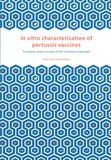In vitro characterization of pertussis vaccines Functional analysis as part of the Consistency Approach

Hoonakker, Marieke
- Promoter:
- Prof.dr. C.F.M. (Coenraad) Hendriksen & prof.dr. W. (Willem) van Eden
- Co-promoter:
- Dr. W. (Wanda) Han & dr. A. (Arjen) Sloots
- Research group:
- Eden
- Date:
- January 12, 2017
- Time:
- 10:30 h
Summary
The current paradigm in vaccine lot release testing is that each final lot of vaccine produced is unique, due to the considerable inherent variation in the preceding biological production process. Consequently, each individual vaccine lot needs to be tested for safety and potency, frequently involving animal experiments. Most of the animal models used for this purpose have been developed in the ‘50s and ‘60s of the previous century and have not changed since. These model are increasingly being criticized because of a lack of scientific relevance, variability in test results and animal welfare concerns. However, in the last decades many aspects of the production processes, as well as the instruments to monitor and control both the process and its products have improved significantly. A more contemporary strategy for vaccine lot release testing might therefore be to monitor vaccine quality and safety in the context of ensuring consistency in the vaccine production processes. This should be paralleled by extensive characterization of the intermediates and final product; a strategy referred to as the Consistency Approach. For evaluation of intermediates and final products of diphtheria and tetanus vaccines, various physic-chemical and immune-chemical methods, such as gel electrophoresis, chromatography methods, mass spectrometry, are available that enable assessment of antigen composition, antigen conformation, antigen stability, antigen-adjuvant interaction, presence of (im)purities and sterility.
In this thesis, cellular in vitro methods were explored for their ability to complement physico-chemical and immune-chemical methods and for their capacity to monitor functional aspects of vaccines - i.e. relevant immunological and safety properties. For our studies we used both routinely produced and experimentally produced Bordetella pertussis (whooping cough) vaccines. Along with this, the additional value of several existing physico-chemical and immune-chemical methods was investigated, since such techniques had not been evaluated for pertussis vaccines thus far. To examine the potential of these methods as indicators of vaccine quality, the in vivo potencies of our experimental vaccines were assessed, as well as the type and magnitude of immune response induced by these vaccines.
The studies in this thesis indicate that in vitro cell-based assays and physico-chemical tools, such as antigen presenting cells, (immunological) reporter cell lines and mass spectrometry can monitor the consistency of pertussis vaccine quality, along with production parameters. In addition, in vivo studies showed that the in vitro immune stimulatory properties of our vaccines coincided with in vivo potencies and in in vivo antibody and T helper cell responses. These results provided a proof-of-principle for the individual components of the consistency approach for B. pertussis vaccines, though it will be necessary to validate each of the methods and the consistency approach as such, and to define a strategy for integrating product and process information. Since the analytical in vitro and in vivo methods described in this thesis assess aspects of vaccine quality that are fundamental for product safety and efficacy, we anticipate that these methods will contribute to the policy to Reduce, Refine and Replace the use of animals (the so-called 3Rs) in pertussis vaccine lot release testing.